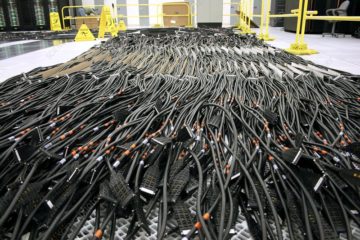I once thought that the more intelligent people got, the less chance there was that they would believe in God. I had a false idea that science and God were at opposite ends of a spectrum.
How could I have been so wrong?
I now realise that the MORE we know about how the world works – especially the human body – the more we recognise it couldn’t have happened by chance – there had to be a Designer.
The human body is really such an incredible system that it beggars belief. We can only marvel at the creation of God. And few areas are more amazing than the stem cell system, a highly co-ordinated response system in our bodies that will blow your mind!
What are stem cells?
Stem cells are the prototypes of mature cells. They are undifferentiated but can become bone, muscle, cartilage and other specialized types of cells. This is why babies’ umbilical cords contain stem cells – because there are lots of them in babies who needs many new cells.

Because of their ability to form into a variety of cells, they have the potential to treat many diseases, including Parkinson’s, Alzheimer’s, diabetes and cancer. Eventually, they may also be used to regenerate organs.
However, we don’t have to wait for science to develop a way to implant stem cells in us all. Our own body has its own store of them already, as well as a way to activate them. And, as you may not be surprised, it is all to do with food – how much food we eat – and how much we DON’T eat!
What stem cells fix exactly
We all know that bodies get damaged and wear out. When your car gets damaged or broken, it has no way of fixing itself; so you take it to a garage and have things removed and added. Not so our bodies. We have built-in fixing mechanisms. Several of them. We just have to know how to activate them. The stem cell system is part of this fixing system.

There are two types of damage that can happen to our bodies at the cellular level:
- The organelles within cells wear out or get damaged – the cell components, and
- The whole cells themselves – these get past the point of no return and need to be fully replaced. Too many components are damaged to make it viable to fix the parts.
Our bodies would prefer to fix something, like filling a cavity in a tooth, rather than having to remove it altogether. The body has its own wisdom as to what would be best in which case.
Don’t mix up autophagy and stem cells
There are two processes for these dealing with this cellular damage:
- autophagy – fixes the insides of cells, and
- regeneration – replaces old cells entirely with new cells – and this is where stem cells come in.
The same activation process for cell regeneration also causes autophagy (cell component fixing). Because autophagy (the smaller fix-up process) takes less effort than the regeneration of the whole cell. That’s where people get mixed up.

This post is focussing on the regeneration of whole cells, not autophagy. This is needed where people are showing their age and illness is manifesting.
When this regeneration is happening to whole cells, we know that autophagy is also happening to cell components.
But when autophagy (the smaller cell-component fixing process) is happening to cell components, regeneration of whole cells is not always happening as well.
The 2 phases of Cell regeneration
First – to get stem cells into the game, you have to take the damaged cells out of the game – like taking tired players off the team so the fresh players can go out onto the field.
Second – after the damaged cells are killed or broken down and then removed, the stem cells have to be brought out of storage and put in place as full players.

These are two separate phases and require two different actions. People often do the first, assuming the second will now follow – but research shows this is not the case at all.
How to remove damaged cells
The tried and tested method to get damaged cells out of the game (get rid of them by killing them or breaking them down) – is to fast!
To fast means to go without food.
Prolonged fasting reduces circulating hormone levels like IGF-1. Multiple cycles of fasting have been proven to reduce the immunosuppression and mortality caused by chemotherapy by protecting white blood cells.
This is showing real benefits in diabetes, cardio-vascular disease, Alzheimer’s, autoimmune diseases as well as cancer.
Fasting is not a fad. People have been doing religious fasts for hundreds and thousands of years – the Christian fast of Lent before Easter, the Muslim fast of Ramadan, the Buddhist fasting. And now we have the popular ‘intermittent fast’ – which may range from an overnight fast to an 18 hour fast, to a day or two a week. There are various ways for people do this.
But do all these fasts actually result in the removal of damaged cells?
NO – they do not.
They may help to reset the appetite, or empty the stomach or lose a little weight in some cases, and most of them will at least begin the phase of autophagy (removing cell components).
But they do not all cause the body to regenerate itself – which starts with the removal of damaged cells.

Even though all fasts involve abstaining from food, they provide different health benefits. To say intermittent fasting is the same as a longer fast is like comparing a 15-minute walk with a marathon. Both bring very different results.
All fasts are not equal.
In order to move into the regenerative phase, which begins with the removal of damaged cells, a body must first move from sugar burning to fat burning. This takes 2 – 3 days of abstention from food.
A fasting equivalent that works
Some interesting research has been done in the last decade showing that this same effect of fasting for 2 – 3 days can be obtained while still eating – but eating a lot less – for 5 days. ‘A lot less’ means about half the usual calorie amount, and using a restricted macronutrient range: reducing carbohydrates to about 50% of the diet’s calories and the other 50% being from plant-based fats.
This diet is called the “Fasting-Mimicking Diet”. You can listen to the chief researcher, Professor Walter Longo, talk about it <here> in this 1 ½ minute video.
This means that instead of suffering the deprivation and difficulty of a full 2 – 3 day water-only fast, you can do this very specific 5 day low calorie ‘fast’, and get the same results. Note: this is not a “low calorie diet” – the macronutrient content is very regulated. This has undergone a lot of study and is being currently trialled for many specific diseases in hospitals around the world. Contact me <here> if you would like to know more about this fasting alternative.
The sense behind removing damaged cells
It makes perfect sense to the body to remove damaged cells. When the body gets into fasting mode, and autophagy is happening and damaged cells are being removed, it can:
- firstly, save energy. (There are now fewer cells to maintain, especially damaged and less active cells).
- Further, as cells die off and cellular components break down – these breakdown products can provide energy to other (more needed) cells.
How to get stem cells to take the place of the old cells
First of all – stem cells are waiting in each organ, ready to play. They have been there since our conception. But because of our steady consumption of food, they may never be used. What a shame!
A response system of our body to allow us to live longer has been ignored because we eat too often and too much.
It is interesting that old religious books including the Bible, speak of gluttony as a sin, but we modern people overlook that. And miss out on these benefits to our own detriment.

However, to get the stem cells INTO the game so they fill the right positions and stay there is not as easy as just getting the old damaged players OUT OF the game. It is not just a matter of fasting now and then. This is where many fast-ers make mistakes.
Much research has shown that by resuming a normal Western diet right after the fast will mean no stem cells take their places as new cells. Old cells are removed – but no new cells replace them. The person may now have a flatter stomach; they may have lost some water and muscle weight (this is practically all the weight loss a fast causes – don’t be mistaken – don’t fast if you want to build muscle or need your muscle!). They have deprived themselves of food – but not got new replacement cells. This means it will do little toward improving a health condition or extending their life.
To get this cell regeneration using stem cells to work, you must eat an appropriate refeed diet.
The refeed diet proven for stem cell replacement
Eating a diet to prolong the benefits of a 2 – 3 day water-only fast or a 5-day ‘fasting mimicking diet’ fast can reduce the risk of a number of diseases for up to 3 months.

A whole-food, plant-based diet that may include fish allows cell regeneration with stem cells to occur. An example is a diet that is 60% carbohydrate, 30% fat and 10% protein. These are all plant foods, except for fish. Note that fish is not necessary, but allowable. Also, please note that this is not the opinion of someone trying to put together a ‘healthy’ diet; it is the dietary pattern proven in the laboratory as well as in human populations, to bring about these changes.
Fasting but returning to a normal Western diet negates the effect of the fast by not bringing stem cells into play to replace the damaged cells. You have got rid of damaged cells, but now have very limited new replacements.
Caveat – don’t fast or restrict calories if….
You have kidney or liver diseases. If you are anorexic or underweight. Or pregnant. Or over 70 unless in excellent health and with Dr’s permission. If you’re fragile. Serious stages of disease shouldn’t fast without professional supervision. If on prescription drugs (or insulin) or have low BP; if you are an athlete during training or competition.
Extremely low calories diets done for extended periods can cause immune system deficiencies, wound healing problems, extremely low weight and high levels of stress. This is why I don’t advise a continually calorie-restricted diet to prevent disease.
Water fasting can raise kidney stone risk, cardiovascular risk, and increase blood pressure anomalies. For this reason I recommended not to fast beyond 3 days without medical supervision. They are also dangerous for people on prescription drugs.
Summary
We have a whole grand system hidden in our bodies, waiting for us to use it to extend our lives and make us, at least, feel more youthful. And hidden it will stay as long as we continue eating and living as Westerners do. Too much food, eaten too often means this system never switches on.
I hope this post encourages you to take advantage of this system to improve your health. Please contact me with further questions or advice on how to work through these health-promoting protocols.



0 Comments